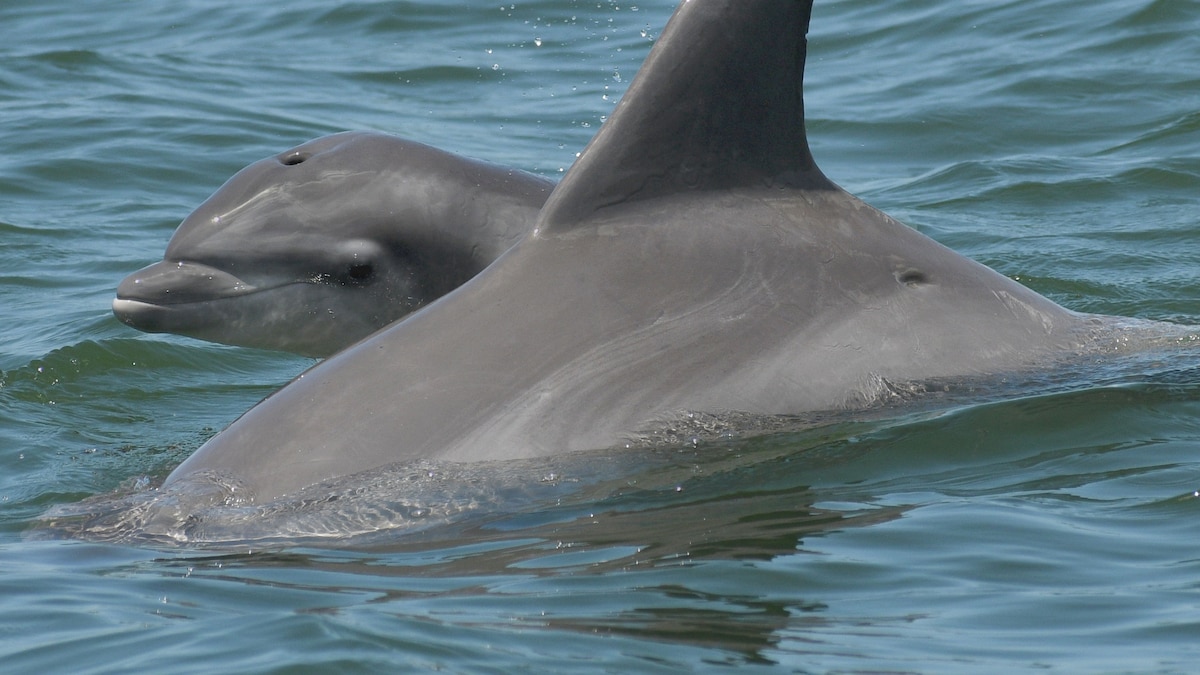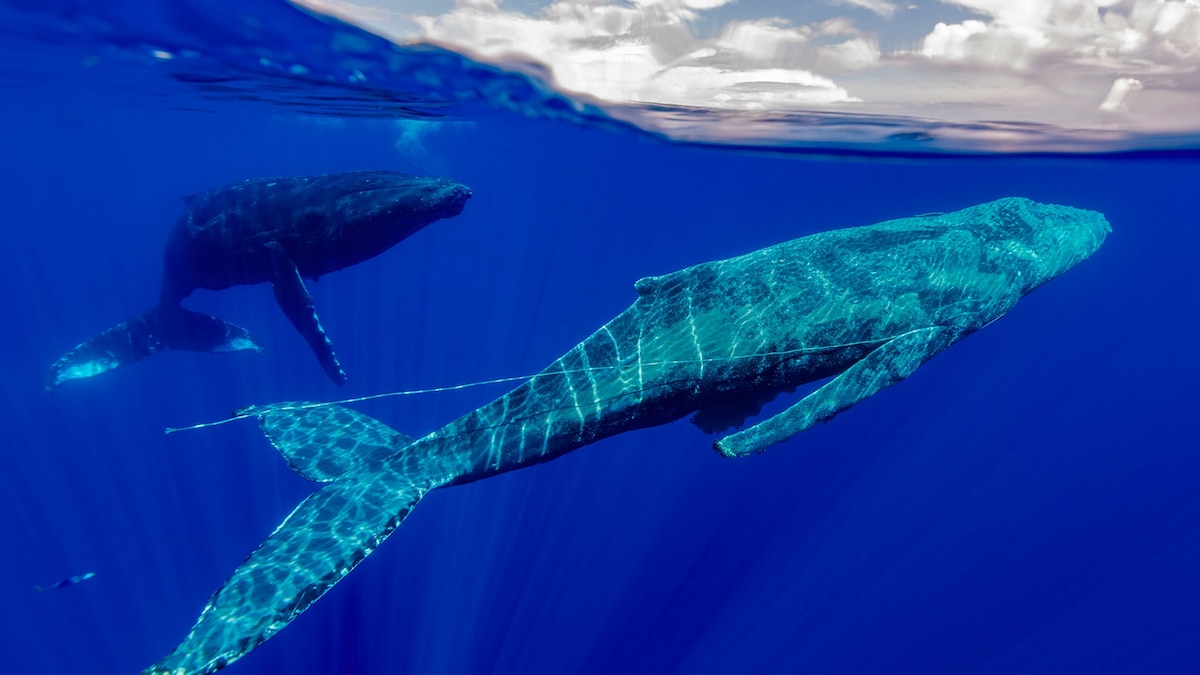Now Reading: Do these Florida dolphins have a language? Scientists are finding new clues.
-
01
Do these Florida dolphins have a language? Scientists are finding new clues.
Do these Florida dolphins have a language? Scientists are finding new clues.

Dolphins are some of the most vocal animals in our oceans. Their pods are a bustling soundscape of clicks, whistles, and buzzy pulses. What to our ears is a creaking door or a melodic pop is to a dolphin a means to echolocate or communicate.
They even have names—research has found they use ‘signature whistles’ to identify themselves, a sort of vocal version of a human’s signature. These whistles are produced by one individual and repeated by another—“Jeff, Jeff”—to initiate or re-establish contact. The discovery back in 2013 that dolphins imitate each other’s whistles showed that these cetaceans can understand and learn these unique sounds—a complex cognitive feat for non-human animals.
Now a talkative bunch of wild bottlenose dolphins have revealed another talent: they appear to be using a broad repertoire of whistles that are not names. So far, researchers have identified 22 of these ‘non-signature whistles’ used by dozens of the dolphins.
“We have these non-signature whistles that seem potentially like they could function like words of some kind, with specific meanings,” says Laela Sayigh, a marine biologist at Woods Hole Oceanographic Institution and Hampshire College in Massachusetts. Sayigh and her team were recently awarded the Coller-Dolittle Prize for Two-way Inter-species Communication.
Two of the whistles—with the catchy names NSWA and NSWB—seem to have a common function, one an alarm, the other a query, respectively. The findings, recently published as a preprint on bioRxiv, raise the question of whether dolphins may communicate using something akin to a language.
“If this pans out, it’s a very, very big discovery in terms of understanding dolphin communication,” says Arik Kershenbaum, a zoologist at the University of Cambridge who was not involved in the research. But it’s a big stretch at this point to consider these sounds similar to words, he says. “Non-signature whistles have been of interest to researchers for ages and ages and no one’s really got very far working on that. They’re the big advantage of this study.”
Creating a catalogue of dolphin chatter
The idea that dolphins may have a language dates back to the 1960s, though any conclusive evidence has remained elusive. Studying communication among an underwater species is difficult to observe and dolphins don’t make any recognizably consistent movements linked to their sounds.
Yet for over forty years, scientists in the Sarasota Dolphin Research Program have carried out regular health assessments on a six-generation pod of around 170 wild dolphins that live in the waters around Florida’s western coastline.
As dolphins surfaced for air, researchers were able to record decades of dolphin vocalizations by briefly placing underwater microphones called hydrophones on their heads, as they swam in temporary net corrals.
In 2012, the same research team began using digital acoustic tags fitted with suction cups, that ride on the back of the animals as they swim freely. These captured high-quality sounds and movement underwater. The result of this data is a giant catalogue of dolphin chit chat, based on more than 1,000 recording sessions made over the past 40 years.
Commonly shared whistles
Around 2017, while digging into some of this data, Sayigh noticed a strange whistle with an unusual flat tone in the middle. She was surprised to notice it was then used by another dolphin.
“I kind of thought I was going a little bonkers,” she says. But her team has now found more than 35 of the dolphins using the same signal.
You May Also Like
Based on the context in which the dolphins make it, the researchers think this whistle—NSWB—could function as some sort of question.
In one instance, the researchers were running an experiment using a hydrophone dipped in the surface of the water. When they played the signature whistles of two closely bonded male dolphins as they swam together—they heard the query in return.
“On the boat we were joking that it was the ‘WTF’ whistle,” says Sayigh. “It was kind of like, ‘what’s going on? We’re together, but we’re hearing us whistling to each other’.”
The second most common non-signature whistle, NSWA, has been used by over 25 individual dolphins and is a punchy combination of up-and-down sweeps. During a series of trials using drones to monitor movement, the whistle seemed to cause most dolphins to avoid the source.
“That doesn’t absolutely mean it’s an alarm type call, but it seems like a reasonable starting point as a hypothesis,” says Sayigh.
Jason Bruck, a biologist at Stephen F. Austin State University in Texas who was not involved in the study, says that really nailing down what the whistles mean will be a big challenge that will need good behavioral data. “If the animal swims away from the whistle, did you offend it somehow? Did you play an alarm whistle? Did you whistle something that was so loud it scared them? You have no idea what’s going on inside that animal’s head.”
What qualifies as dolphin language?
The research is still in its infancy. But dolphins are life-long learners, appear to use specific names, and females communicate at higher frequencies with their children—like human “motherese.” The research team in Sarasota thinks this all suggests a wider repertoire of shared sounds that could reflect a starting point for a ‘language-like communication system’.
“If there is a species that we might be able to kind of try to engage with in some kind of two way communication, these guys are really good candidates,” says Sayigh.
Whether or not the dolphins’ communication is ‘language-like’ depends on how ‘language’ is defined, says Sara Torres Ortiz, a biologist at the University of Southern Denmark also not involved in the research.
If the criteria is referential signaling— specific sounds referring to specific objects or events—this ability has been seen in other animals, including vervet monkeys and prairie dogs. “Given these precedents, it would not be surprising if dolphins also possess some form of referential communication,” she says.
Other animals may even have communication systems that are more effective than the sounds and cues that humans think of as language, says Bruck, including dolphins who collect information about their friends through urine. “If we take the animals out of our own heads and we take them for what they are, you find that there’s a lot of complexity in what they do as it is.”
























